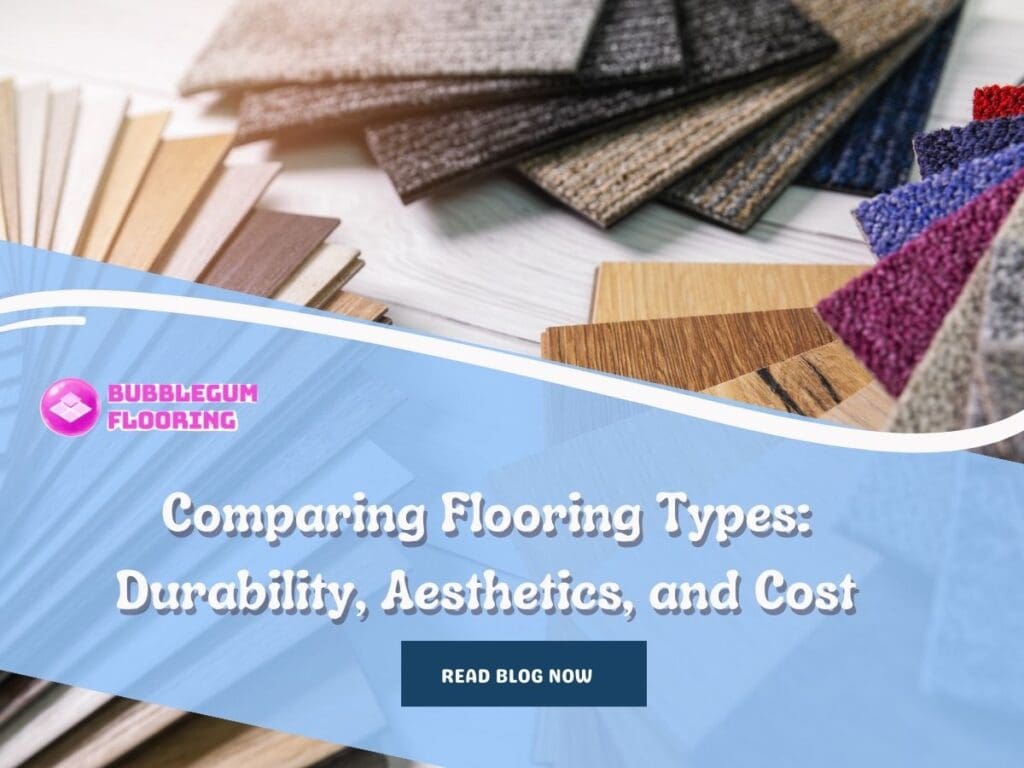It’s not ideal to have to change your floor installation every few years because it’s a costly and time-consuming task. Even so, you don’t want to have to put up with regular dings and scratches from daily living on your floors.
The choice of flooring for your house has a big influence on how useful and aesthetically pleasing your living area is. Beyond just the surface, flooring affects comfort, atmosphere, and even the value of your property should you decide to sell it.
Through the many flooring options available, this article seeks to assist you in making an informed decision that fits your lifestyle, preferences, and budget. Let us start comparing flooring types.
| Flooring Type | Cost per Square Foot |
| Bamboo | $4 to $8 |
| Vinyl | $2 to $5 (plus installation $1.50 to $6 or more for LVP and LVT) |
| Ceramic and Porcelain | $8 to $15 (ceramic), $3 to $10 (porcelain) |
| Laminate | $2 to $8 (installed cost $3 to $7) |
| Solid Hardwood | $8 to $15 |
| Engineered Wood | $4 to $9 |
| Concrete | $2 to $15 or more |
Types of Flooring
Keep in mind that every style of flooring, from vinyl to hardwood, has a place in your house when selecting new flooring. Flooring material advancements have expanded alternatives across a spectrum of costs.
1. Bamboo
Bamboo, a resilient grass, transforms into an appealing and durable flooring option. Being a rapidly renewable resource, bamboo reaches maturity in as little as five years making it a sustainable and environmentally conscious choice.
Its ability to thrive in various climates and resist moisture enhances its adaptability, making it suitable for a wide range of room environments.
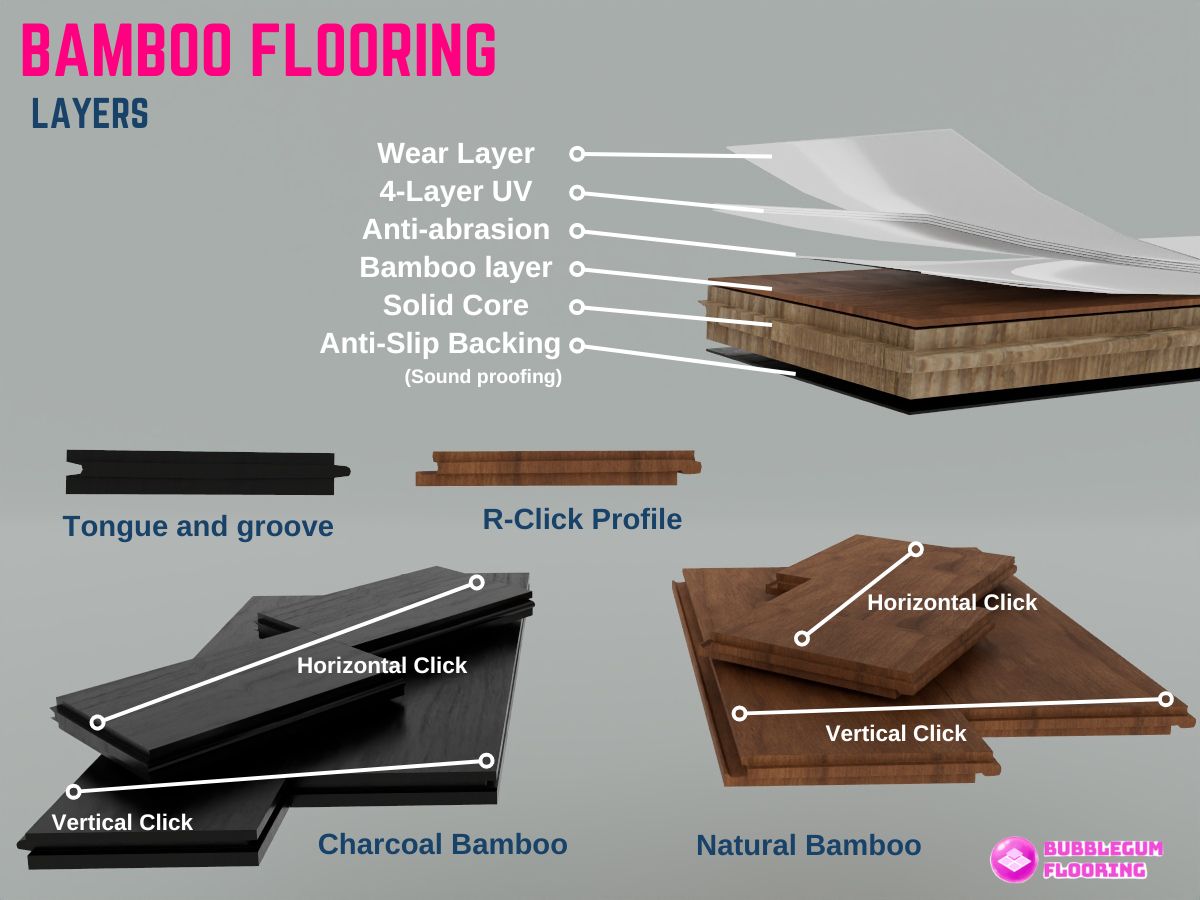
Durability
Bamboo flooring stands out for its impressive durability, often surpassing traditional hardwoods in hardness. The cross-directional placement of bamboo stalks and the use of robust adhesives, particularly in woven strand bamboo flooring, contribute significantly to its toughness.
Aesthetics
The visual allure of bamboo flooring is distinctive, offering a contemporary and sleek appearance. With various styles, ranging from natural to carbonized, bamboo provides a versatile canvas for design.
Its unique manufacturing process, involving cutting, shredding, pressing, and gluing strands of grass, results in a floor that is both unique and attractive.
Cost
Bamboo flooring falls within a moderate price range, typically ranging from $4 to $8 per square foot. Installation costs are comparable to hardwood, and for those with DIY experience, there’s an opportunity for additional cost savings.
2. Vinyl Flooring
Vinyl flooring lives up to its name as a moisture-resistant and long-lasting flooring option. Resilience is a key feature, and it comes in various forms like sheet vinyl, plank , and tile.
Designs mimic other flooring types, making it an ideal choice for rental properties seeking a balance between durability, aesthetics, and cost-effectiveness.
Durability
Vinyl flooring, with its resistance to wear, dents, scratches, and stains, proves itself as a durable option. Sheet vinyl, specifically, stands out with scratch resistance, water resistance, and impact resistance, making it one of the most robust choices.
SPC flooring, with its stone polymer composite core, adds another layer of durability with the ability to withstand uneven subfloors.
Aesthetics
Vinyl offers a versatile range of colors, patterns, and styles, including realistic wood and stone replicas. This diversity allows for customization, and the softer, warmer feel underfoot distinguishes it from some harder surfaces.
Luxury vinyl flooring (LVF), in particular, can convincingly mimic the appearance of stone, tile, or wood.
Cost
Affordability is a key advantage of vinyl flooring, generally costing between $2 to $5 per square foot. DIY installation is common, contributing to overall cost savings. However, it’s essential to note that the highest quality LVF can rival or exceed the cost of the best solid wood and laminate floors, as the installation price can range from $1.50 (sheet vinyl) to $6 or more (LVP and LVT) per square foot.
3. Ceramic and Porcelain
Ceramic and porcelain tiles, renowned for their enduring beauty, do face challenges in certain scenarios but prevail as favored flooring choices due to their captivating appearance.
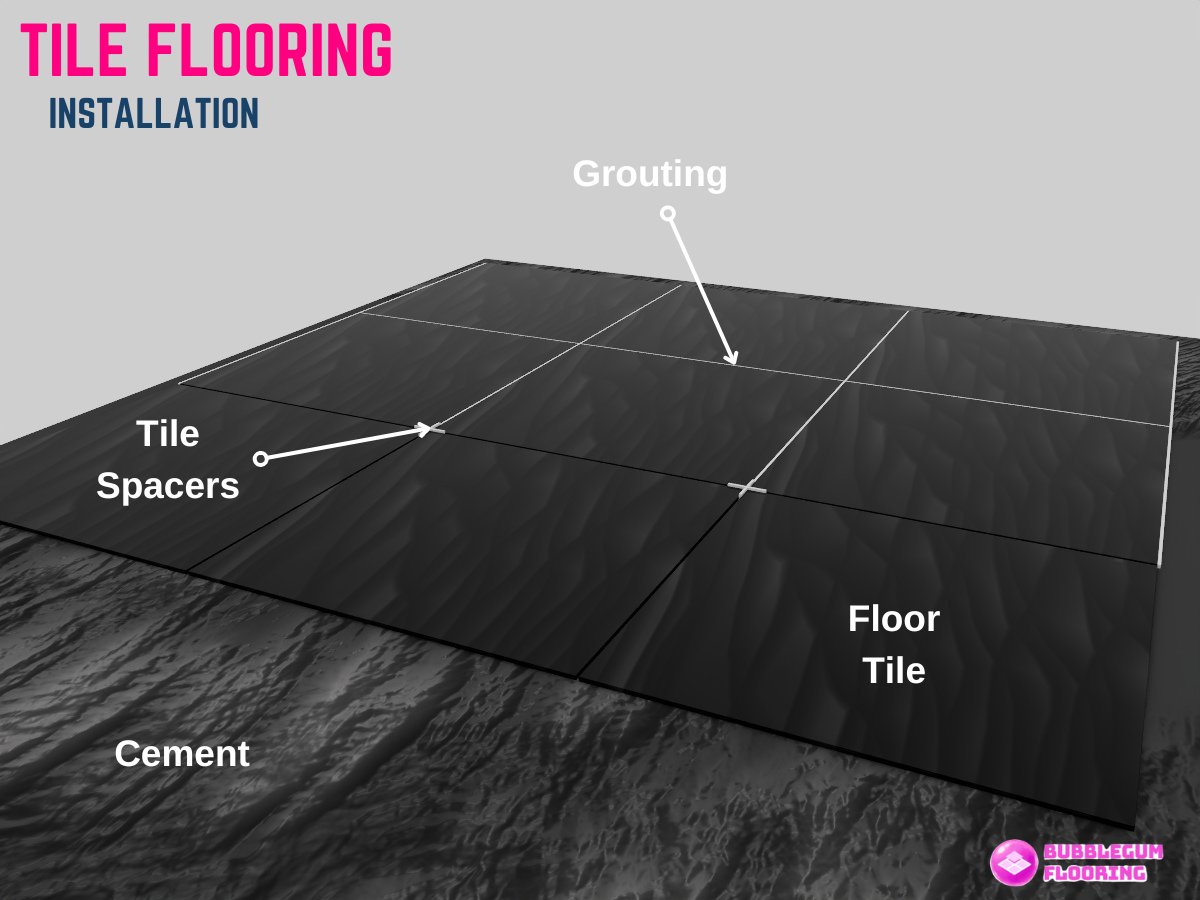
Durability:
Expert installation significantly enhances their durability, addressing issues such as improper underlayment or voids that can contribute to cracking. Porcelain, fired at higher temperatures, surpasses ceramic in durability and weather resistance, making it suitable for both indoor and outdoor use.
Ceramic tiles, with their hard and solid composition, resist dirt, dust, and allergens, providing a clean and safe environment for asthmatics and allergy-prone people. Porcelain tiles, made from finer, denser clay and fired at higher temperatures, offer superior durability, scratch resistance, and stain resistance.
Aesthetics
Tile flooring, be it ceramic or porcelain, offers a diverse range of colors, patterns, and sizes, mimicking the natural beauty of stone. This versatility provides an elegant and sophisticated appearance, making it a preferred choice for homeowners seeking a visually appealing flooring option.
Cost
While the installed cost ranges from $8 to $15 per square foot for ceramic and porcelain tiles, the investment in these classic materials is often deemed worthwhile. Products that can float may have a lower cost, ranging from $1 to $8 per square foot. Porcelain tiles are slightly pricier, ranging from $3 to $10 per square foot.
| Aspect | Ceramic Tiles | Porcelain Tiles |
| Durability | Hard, solid composition; resists dirt, dust, allergens | Finer, denser clay; higher temperature firing; superior durability, scratch and stain resistance |
| Suitability | Indoors | Both indoor and outdoor use |
| Aesthetics | Offers diverse colors, patterns, sizes; mimics stone beauty | Similar diverse range with elegant and sophisticated appearance |
| Cost (Per Square Foot) | $8 to $15 (installed cost); $1 to $8 for floating products | $3 to $10; slightly pricier than ceramic |
4. Laminate
Composed of composite construction with a plywood or fiberboard core, laminate floors feature a photographic image layer that convincingly replicates the look of wood, stone, or other materials. This image layer is protected by a clear plastic wear layer, enhancing the floor’s resistance to scratches and stains.
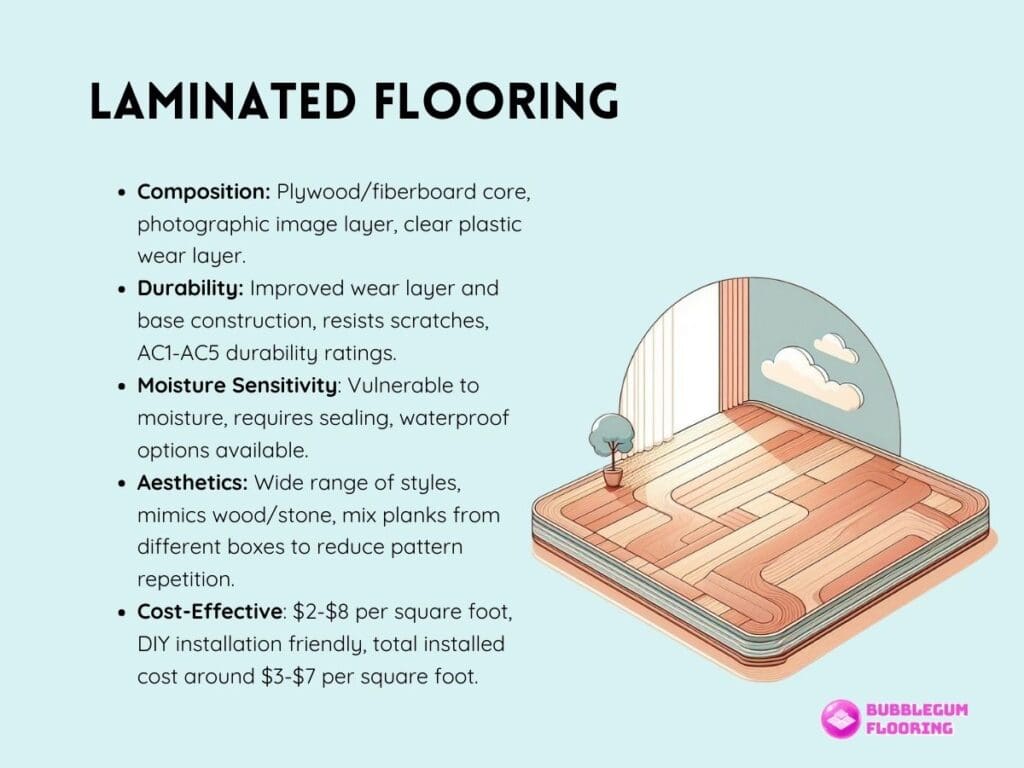
Durability
Laminate flooring has witnessed significant improvements in durability, primarily attributed to advancements in its wear layer and base construction. The transparent wear layer, a key component, exhibits remarkable resistance to scratches caused by activities such as pet claws and furniture movement.
The Abrasion Class (AC) ratings, ranging from AC1 to AC5, provide valuable insights into the floor’s durability against various traffic levels. While laminate is generally resilient, it is crucial to consider its vulnerability to moisture, particularly at the edges, necessitating proper sealing during installation.
Waterproof laminate is available for moisture-prone areas, but this option eliminates all wood content, blurring the line between laminate and vinyl flooring.
Aesthetics
Laminate flooring offers a diverse range of styles, presenting an affordable alternative to hardwood including realistic wood and tile patterns, providing homeowners with a cost-effective means to achieve the visual appeal of hardwood or stone. The flooring’s construction involves a photographic image layer, allowing it to convincingly mimic various materials.
However, the repetitive pattern inherent in the laminate may compromise realism during installation, requiring a strategic mix of planks from different boxes to reduce repetition. Some brands even incorporate a cork backing to dampen sound, enhancing the overall aesthetic experience.
Cost
Laminate stands out as a budget-friendly flooring option, offering an affordable alternative to hardwood with costs ranging from $2 to $8 per square foot. The cost-effectiveness extends to the ease of DIY installation, allowing homeowners to contribute to cost savings.
The particleboard or fiberboard core, topped with a photographic image layer and a clear-plastic protective layer, contributes to the reasonable installed cost of $3 to $7 per square foot.
5. Solid Hardwood
Solid hardwood floors are best suited for rooms on the first or second floor with limited water exposure and foot traffic. Preferences dictate the choice between prefinished and unfinished solid hardwood floors, with prefinished options offering immediate installation due to their protective coating.
Unfinished hardwoods provide the flexibility to match decor through staining on-site.
Durability
Solid hardwood stands as one of the longest-lasting flooring options due to its ability to be restored to perfect condition. Despite its inherent susceptibility to scratching, the scratches and gouges can be perceived as part of its character and natural beauty.
The use of a drum sander allows for deep sanding, enabling most solid hardwood floors to be brought back to their original smooth appearance. The Janka hardness ratings serve as an indicator of hardwood’s durability and strength, with varieties rated based on their hardness and internal pressure.
Aesthetics
Hardwood flooring, sourced from solid milled wood, exudes a timeless elegance and natural warmth that enriches the aesthetic appeal of any space. Popular hardwood varieties, including maple, oak, walnut, or cherry, offer versatility and quality.
The diversity in wood species, finishes, and stains allows for a wide range of aesthetic options. The natural variations in grain patterns contribute to the flooring’s character, enhancing the overall ambiance of a room.
Cost
While hardwood is a desirable flooring option, it comes with a higher upfront cost, typically ranging from $8 to $15 per square foot. Installation costs can be on the higher side, often exceeding the material cost.
6. Engineered Wood
Engineered wood flooring emerges as a durable, aesthetically pleasing, and cost-effective flooring option. Its layered composition imparts durability, withstanding humidity variations, and providing water resistance.
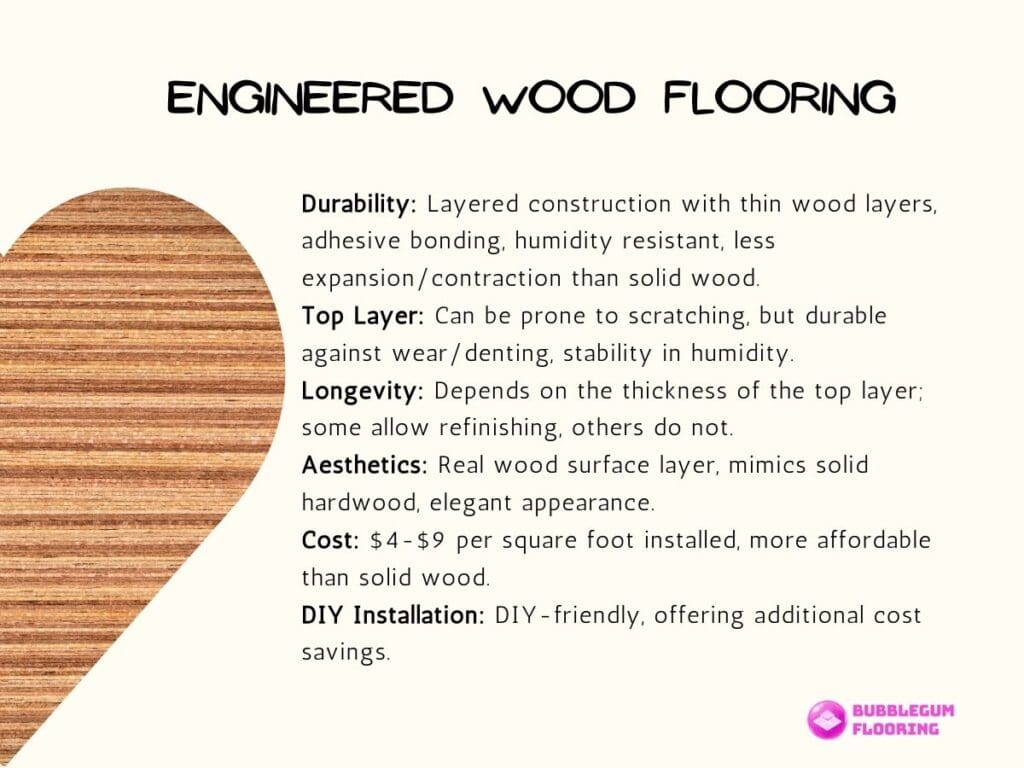
The visual appeal of real wood, coupled with budget-friendly pricing and DIY installation capabilities, makes it a compelling choice for homeowners seeking a harmonious blend of durability, aesthetics, and cost-efficiency.
Durability
Engineered wood flooring boasts commendable durability owing to its layered construction. Comprising thin layers of wood sandwiched with adhesives, this flooring type exhibits resilience against humidity, making it less prone to expansion and contraction compared to solid wood.
The top layer, though vulnerable to scratching like solid hardwood, can withstand wear and denting when well-installed and of high quality. It scores favorably in stability, outperforming solid wood by enduring higher humidity variations throughout the year.
However, the longevity of engineered wood is contingent on the thickness of the top “wear layer.” While some products allow one or two refinishing sessions, others lack this capability.
Aesthetics
Engineered wood flooring effortlessly captures the allure of real wood at a more budget-friendly price point than solid wood. Its surface comprises a thin layer of real wood or bamboo bonded over a high-quality plywood substrate, offering the elegance and visual appeal of solid hardwood.
Cost
The cost aspect of engineered wood flooring positions it as a compelling option for budget-conscious consumers. With an installed cost ranging from $4 to $9 per square foot, it provides an affordable alternative to solid wood flooring.
Its DIY-friendly installation further contributes to cost savings, making it an attractive choice for those willing to undertake the installation process themselves.
7. Concrete
Concrete’s popularity in residential spaces is further augmented by its compatibility with radiant heating systems, offering not only durability but also energy efficiency. Additionally, concrete’s ability to absorb and release heat positions it as an excellent choice for homes seeking thermal mass benefits.
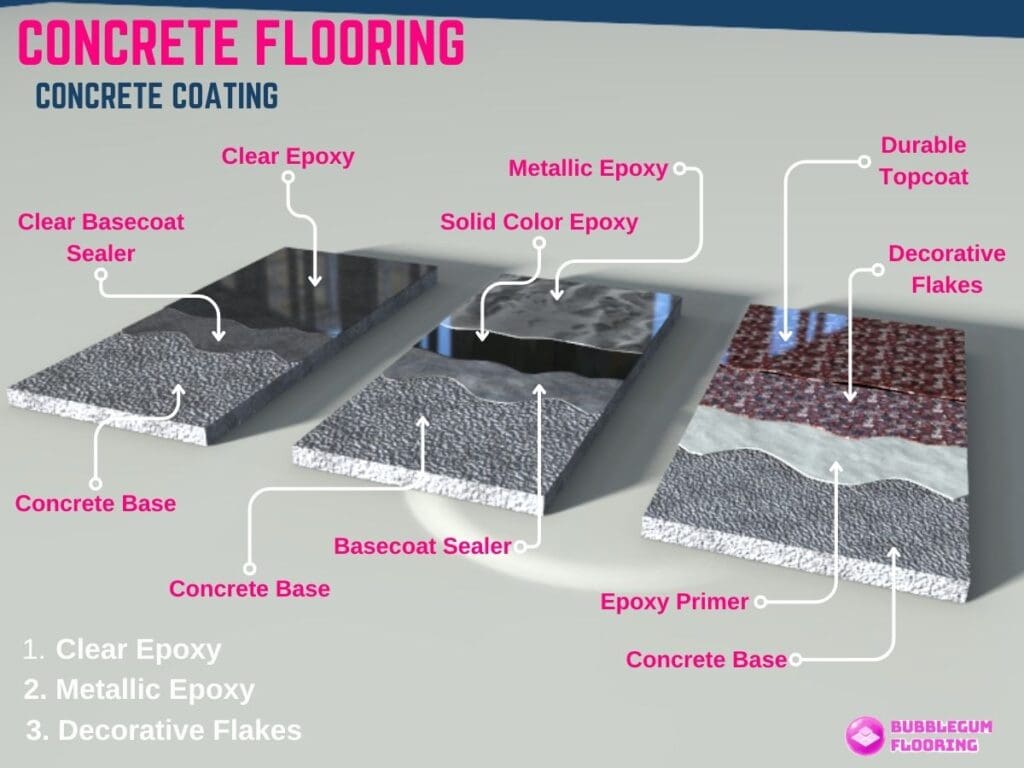
Although comfort may be compromised due to its cold nature, the durability, modern aesthetic, and adaptability of concrete flooring make it a compelling choice for spaces where a moisture- and scratch-resistant surface is paramount.
Durability
Concrete flooring stands out as the epitome of durability, particularly indoors, where it reigns as the most resilient flooring option. Its robust nature renders it impervious to wear and tear when adequately sealed.
This durability extends to resistance against stains, moisture, and abrasions, making it a formidable choice for high-traffic areas. The scratch-resistant quality of concrete adds to its appeal, offering a flooring solution that can withstand the test of time and maintain its pristine appearance.
Aesthetics
The aesthetic allure of concrete flooring has transcended its industrial origins, making it a prominent feature in contemporary residential spaces. Its minimalist and industrial charm contributes to a modern aesthetic that resonates with current design trends.
Concrete’s versatility shines through its customizable finishes, which include polished, stained, or stamped options. This adaptability allows for a spectrum of design possibilities, enabling homeowners to tailor the flooring to their stylistic preferences.
Cost
While concrete flooring falls within a moderate to high price range, its cost considerations are multifaceted. The material itself is competitively priced, with costs ranging from $2 to $15 or more per square foot.
However, the overall expense may vary based on the chosen finish and customization. Professional installation costs can also fluctuate, especially for intricate finishes.
Eco-friendly Flooring Solutions for Milwaukee Residents
After navigating the wide range of flooring options and comprehending the subtleties of cost, durability, and aesthetics, it’s time to draw attention to yet another important factor: eco-friendliness. Your flooring decisions can help create a greener and more sustainable house, whether you choose hardwood’s timeless allure, concrete’s contemporary attractiveness, or the eco-friendly benefits of bamboo and linoleum.
Finding flooring that not only satisfies your aesthetic and financial needs but also matches ecologically conscious principles is crucial, especially in a city that is well-known for its commitment to sustainability. Therefore, while you search for the ideal floor for your Milwaukee home, don’t just focus on its affordability and durability—also take into account its environmental impact.

